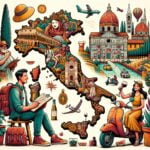Italy is a country rich in history, culture, and influence. From the Roman Empire to the Renaissance, Italy has played a pivotal role in shaping the world we know today.
In “A Traveller’s History of Italy” by Valerio Lintner (1989), readers are taken on a journey through Italy’s past and present, exploring its ancient history, art and architecture, cultural heritage, regional differences, and modern society. This book provides an in-depth look at what makes Italy such a fascinating and enduring destination for travelers.
In the pages of this book, readers will delve into Italy’s ancient history, from the rise and fall of the Roman Empire to the artistic and intellectual achievements of the Renaissance. The influence of art and architecture is also examined, showcasing how Italy’s creative legacy has left an indelible mark on the world. Additionally, “A Traveller’s History of Italy” delves into Italy’s rich cultural heritage, including its contributions to music, food, and fashion.
But it doesn’t stop there – Valerio Lintner also explores Italy’s role in world history and its impact on a global scale. From regional differences between the North and South to modern day politics, economy, and society – this book offers a comprehensive understanding of what makes Italy so captivating for travelers.
Whether you’re planning a trip or simply want to deepen your knowledge of this remarkable country, “A Traveller’s History of Italy” is an essential read for anyone seeking to understand Italy’s past and present.
Exploring Italy’s Ancient History
A Traveller’s History of Italy by Valerio Lintner provides a comprehensive look at the ancient history of Italy, from the time of the Roman Empire to the Renaissance. This section will delve into the fascinating journey through time and explore the key historical events, figures, and cultural developments that have shaped Italy into the country it is today.
The Rise and Fall of the Roman Empire
Italy’s ancient history is closely linked with the rise and fall of the Roman Empire, which had a significant influence on European and world history. The book delves into the power struggles, conquests, and achievements of this mighty empire. It explores how Rome’s political organization, military prowess, and engineering feats left a lasting legacy on Italy’s landscape and culture.
The Renaissance: A Rebirth of Art and Learning
The period known as the Renaissance was a pivotal time in Italy’s history, characterized by an explosion of creativity in art, literature, science, and philosophy. A Traveller’s History of Italy highlights how this cultural revival not only transformed Italian society but also had a profound impact on Europe as a whole. Readers will gain insight into renowned artists like Leonardo da Vinci and Michelangelo, as well as influential thinkers such as Galileo Galilei.
Understanding Italy’s Ancient History for Modern Travelers
By exploring Italy’s ancient history through A Traveller’s History of Italy, readers gain a deeper appreciation for the country they are visiting. Understanding how Italy evolved from its ancient roots to its present-day form enriches any travel experience in this historically rich land. Whether strolling through Rome’s iconic Colosseum or admiring Florence’s Renaissance architecture, having knowledge of Italy’s ancient past adds depth to every traveler’s journey.
The Influence of Art and Architecture in Italian History
Italy is widely recognized for its rich artistic and architectural heritage, which has played a significant role in shaping the country’s history. From the grandeur of ancient Roman structures to the exquisite beauty of Renaissance art, Italy’s influence on the world of art and architecture is unparalleled. Valerio Lintner’s “A Traveller’s History of Italy” provides a comprehensive overview of how art and architecture have influenced and reflected Italy’s history over the centuries.
Ancient Rome: The Birthplace of Architectural Mastery
One cannot delve into Italian art and architecture without exploring the legacy of Ancient Rome. The Roman Empire left a lasting mark with its engineering marvels such as the Colosseum, aqueducts, and roads that stretched across vast territories. These structures not only showcase exceptional craftsmanship but also highlight the power and grandeur of the Roman civilization.
The Renaissance: A Flourishing Era for Art and Innovation
The Renaissance period marked a resurgence in artistic creativity, scientific advancement, and cultural rebirth. Italian artists such as Leonardo da Vinci, Michelangelo, and Raphael produced masterpieces that continue to captivate audiences worldwide. Lintner’s book delves into how these artistic achievements reflected the intellectual and cultural changes taking place during this pivotal era in Italian history.
The Influence of Italian Architecture on Global Design
Italy’s architectural prowess has had a profound impact on global design trends. From iconic landmarks like the leaning Tower of Pisa to elaborate cathedrals and palazzos, Italian architecture continues to inspire architects around the world. Lintner’s exploration of this influence sheds light on how Italian art and architecture have left an indelible mark on both historical and contemporary design movements.
Italy’s Rich Cultural Heritage
Italy’s cultural heritage is as diverse and rich as the country itself. From the melodies of opera to the delectable flavors of Italian cuisine, and the iconic fashion houses that have left an indelible mark on the world, Italy’s cultural contributions are unmatched. A Traveller’s History of Italy by Valerio Lintner provides a comprehensive look at how these elements have shaped Italy’s identity and continue to influence global culture.
Music in Italy holds a special place in the hearts of both locals and visitors. From the timeless compositions of composers like Verdi and Puccini to contemporary stars like Andrea Bocelli, Italy has been a pioneer in classical and popular music.
Opera, in particular, has its roots deeply embedded in Italian history and remains a vibrant part of the country’s cultural scene. Travellers can experience this musical heritage firsthand by attending performances at historic theaters such as La Scala in Milan or Teatro di San Carlo in Naples.
Italian cuisine is celebrated worldwide for its fresh ingredients, simple yet flavorful recipes, and regional diversity. Whether it’s savoring a plate of creamy risotto in Lombardy, indulging in Neapolitan pizza with its thin crust and flavorful toppings, or relishing handmade pasta dishes in Tuscany, each region offers a distinct culinary experience. A Traveller’s History of Italy delves into the origins of these dishes, revealing how historical influences have shaped Italy’s culinary traditions.
When it comes to fashion, Italy is synonymous with luxury and elegance. Renowned designers like Gucci, Prada, Versace, and Dolce & Gabbana have made Italian fashion synonymous with glamour and sophistication. The book provides insight into how Italian fashion has evolved over centuries, from traditional craftsmanship to modern couture. Travellers can explore this aspect of Italian culture by visiting fashion museums such as the Galleria del Costume in Florence or taking a tour through Milan’s Fashion District.
The Role of Italy in World History
Italy has played a significant role in world history, with its influence and impact being felt across various aspects of society. A Traveller’s History of Italy by Valerio Lintner delves into the country’s rich historical background and how it has shaped the modern world. From its contributions to art, architecture, and literature to its strategic geopolitical location, Italy’s role in world history is undeniable.
One of the most notable contributions of Italy to world history is its influence on art and architecture. The Italian Renaissance, in particular, marked a period of great cultural revival that had a profound impact on the rest of Europe.
Artists such as Leonardo da Vinci, Michelangelo, and Raphael produced timeless masterpieces that continue to inspire and influence artists to this day. The architectural achievements of ancient Rome also left an indelible mark on the world, with structures like the Colosseum and aqueducts serving as a testament to Italy’s engineering prowess.
In addition to its artistic and architectural legacy, Italy’s impact on world history can also be seen through its political and military endeavors. The Roman Empire once controlled vast territories across Europe, Asia, and Africa, leaving behind a lasting imprint on these regions in terms of language, law, and governance.
Furthermore, Italy’s role as the birthplace of the Renaissance also sparked intellectual and philosophical movements that reshaped the course of human thought and knowledge. Valerio Lintner’s A Traveller’s History of Italy provides readers with a comprehensive understanding of these historical events and their global implications for future generations.
| Aspect | Impact |
|---|---|
| Art and Architecture | The Italian Renaissance influenced European art for centuries. |
| Political Influence | The Roman Empire’s legacy shaped governance systems across continents. |
| Cultural Revival | The intellectual movements stemming from Italy impacted human knowledge worldwide. |
Regional Differences in Italy
Italy is a country known for its rich historical and cultural heritage, but it is also a nation of diverse regional differences. One of the most notable distinctions is between the northern and southern regions of Italy. This divide has deep historical roots and continues to impact Italian society today. In Valerio Lintner’s book, “A Traveller’s History of Italy”, the author delves into the complex and dynamic relationship between Italy’s north and south.
The historical differences between the north and south of Italy can be traced back to ancient times. The northern region, which was once heavily influenced by the Roman Empire, developed a more industrialized and economically prosperous identity. On the other hand, the southern region has historically been more agrarian and has faced challenges in terms of economic development. This regional disparity has contributed to distinct cultural norms, dialects, and even cuisine.
In addition to historical differences, there are also significant social and political variations between northern and southern Italy. The north tends to be more politically conservative and economically affluent, while the south often faces higher rates of poverty and unemployment. These regional disparities have led to tensions within Italian society throughout history, with movements for autonomy or independence in certain southern regions.
Valerio Lintner’s exploration of regional differences in Italy provides valuable insight for travelers seeking to understand the complexity of Italian culture and society. By acknowledging these disparities, visitors can gain a deeper appreciation for Italy’s multifaceted identity beyond its renowned historical landmarks and artistic treasures.
| Regional Differences in Italy: North vs South | Valerio Lintner’s Book |
|---|---|
| Historical Disparities: Roman influence in the north vs agrarian economy in the south | Insightful analysis into regional differences |
| Social and Political Contrasts: Conservative north vs challenges in the south | Relevance for travelers seeking cultural understanding |
| Impact on Italian Society: Autonomous movements in the south | Deeper appreciation for Italian complexity beyond tourist attractions |
Modern Italy
A Traveller’s History of Italy by Valerio Lintner provides a comprehensive look into the modern Italy, covering its politics, economy, and society. This book offers a deep dive into the contemporary issues that shape the country today, allowing readers to gain a better understanding of Italy’s current landscape.
In modern Italy, politics plays a crucial role in shaping the country’s direction and policies. From the fall of fascism to the rise of different political parties, Italy has undergone significant political changes. A Traveller’s History of Italy delves into these political shifts, providing insight into how they have shaped the nation.
Additionally, the book highlights Italy’s economy and its impact on society. As one of the world’s largest economies and an influential member of the European Union, understanding Italy’s economic history is essential for comprehending its present-day challenges and opportunities. Lintner discusses how economic factors have influenced Italian society, from class divides to cultural practices.
Society in modern Italy is also explored in A Traveller’s History of Italy. The book examines social issues such as immigration, gender equality, and cultural diversity, offering valuable perspectives on the country’s social fabric. By shedding light on these aspects, readers can gain a comprehensive view of modern Italian society and its complexities. Ultimately, this section serves as an indispensable resource for anyone seeking to grasp the intricacies of contemporary Italy.
The Importance of a Traveller’s History of Italy in Understanding the Country’s Past and Present
A Traveller’s History of Italy by Valerio Lintner offers a comprehensive and insightful look into the rich and diverse history of Italy, making it an essential resource for anyone seeking to understand the country’s past and present. Lintner expertly weaves together historical events, cultural developments, and societal changes to create a compelling narrative that is both informative and engaging.
By delving into the intricacies of Italy’s history, readers are able to gain a deeper appreciation for the complexities of the country and its people.
One of the key aspects emphasized in A Traveller’s History of Italy is the importance of exploring Italy’s ancient history, from the rise and fall of the Roman Empire to the cultural and artistic achievements of the Renaissance. Lintner provides a detailed examination of this period, highlighting how it has shaped Italian identity and culture.
Understanding Italy’s ancient history is crucial in comprehending its modern society, as many cultural practices and traditions have deep roots in this historical foundation.
Furthermore, Lintner also explores the influence of art and architecture in Italian history, showcasing how creativity and innovation have played a significant role in shaping Italy’s cultural heritage. From iconic landmarks such as the Colosseum to masterpieces by renowned artists like Leonardo da Vinci and Michelangelo, Italian art and architecture have left an indelible mark on global culture.
A Traveller’s History of Italy delves into these artistic achievements, providing readers with valuable insights into their impact on Italian society throughout different time periods. This section further reinforces how art has been intertwined with Italy’s history, influencing its development over centuries.
Conclusion
In conclusion, A Traveller’s History of Italy by Valerio Lintner provides a comprehensive and insightful look into the rich and diverse history of Italy. From the ancient Roman Empire to the Renaissance, and from art and architecture to music and fashion, this book delves into the various aspects that have shaped Italy into the fascinating country it is today.
Lintner’s detailed exploration of Italy’s regional differences, modern politics, economy, and society offers readers a well-rounded understanding of the country’s past and present.
One of the most captivating elements of A Traveller’s History of Italy is its ability to bring history to life for travelers. By understanding Italy’s historical influence and impact on world history, visitors can gain a deeper appreciation for the significance of the country’s landmarks and cultural treasures.
Whether traversing through northern or southern regions, exploring historical sites or immersing in modern Italian life, armed with knowledge from Lintner’s work can greatly enhance a traveler’s experience.
The enduring appeal of Italy’s history for travelers is undeniable. As one of Europe’s most enchanting destinations, Italy continues to captivate visitors with its timeless allure.
A Traveller’s History of Italy serves as an indispensable guide for those seeking a deeper understanding and appreciation of this remarkable country. Through its pages, readers are able to embark on a journey through time – uncovering layers upon layers of ancient ruins, breathtaking artistry, vibrant culture, and significant contributions to world history that continue to enthrall travelers from around the globe.
Frequently Asked Questions
What Happened to Italy After Rome Fell?
After the fall of Rome, Italy went through centuries of political fragmentation and foreign invasions. It was ruled by various foreign powers such as Byzantines, Lombards, and Normans. This period is known as the “Dark Ages” in Italian history.
What Is the Summary of Italy?
Italy can be summarized as a country with a rich cultural heritage, stunning art and architecture, delicious cuisine, and a diverse landscape that includes beautiful coastlines, rolling vineyards, and majestic mountains. It has played a significant role in shaping Western civilization.
What Was Italy Before Napoleon?
Before Napoleon’s conquests in the late 18th century, Italy was a patchwork of independent states ruled by different monarchs and aristocrats. These states included the Kingdom of Sardinia, the Papal States, the Duchy of Milan, the Republic of Venice, and various other smaller territories.

I’m a passionate traveler, writer, and Italophile. My fascination with Italy’s history, art, and culture has led me on countless adventures across the Italian landscape. Through “I Live Italy,” I share my love for this extraordinary country and aims to inspire others to explore its boundless beauty.





